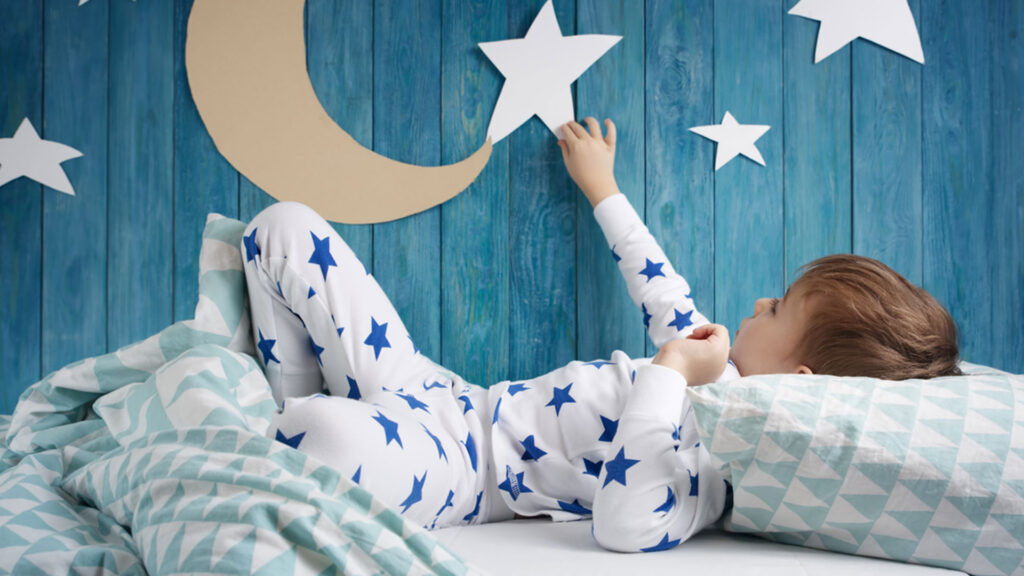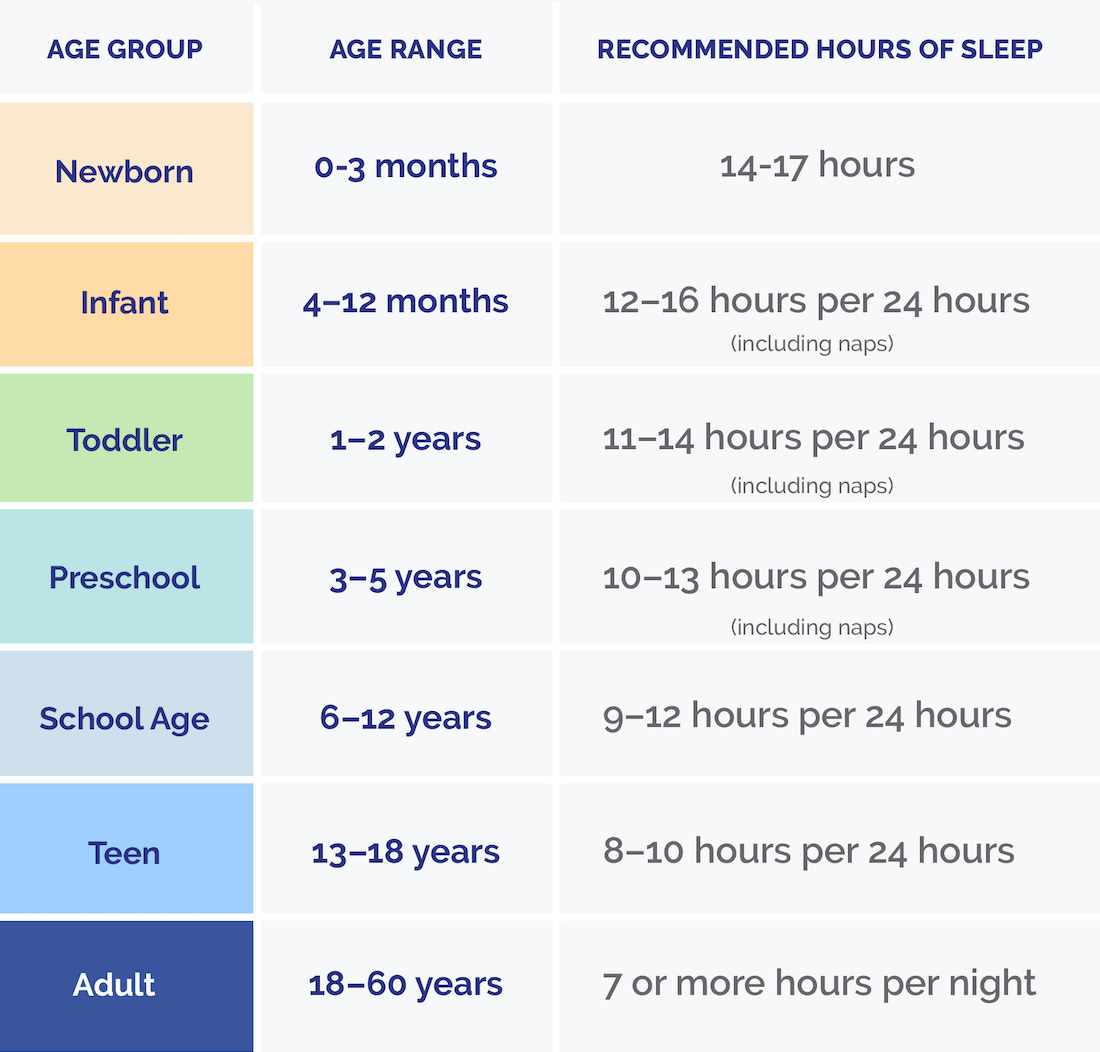
One of the first questions new parents are often asked is how their child is sleeping. The answer can vary significantly depending on the day, but sleep for kids can feel like an uphill battle for many families. With the often conflicting advice that circulates around children and sleep, it can be easy to be overwhelmed when your child is struggling.
Sleep is a crucial part of a child’s growth and development, from infancy all the way into their adulthood. But why does sleep matter so much for kids? And what can parents do to help them cultivate healthy sleep habits?
We’re tackling these questions and more so your family can catch up on all the lost Z’s once and for all.
Note: The content on Sleepopolis is meant to be informative in nature, but it shouldn’t be taken as medical advice, and it shouldn’t take the place of medical advice and supervision from a trained professional. If you feel you or your child may be suffering from any sleep disorder or medical condition, please see your healthcare provider immediately.
Long Story Short
- Getting enough sleep is a critical component of a child’s growth and development.
- Over the years, daily sleep needs gradually decrease from 12-16 hours for infants to 8-10 hours for teens.
- A chronic lack of sleep negatively affects physical and mental health as well as emotional regulation.
- Parents and caregivers can help by encouraging healthy sleep habits, like encouraging consistent bedtime routines, creating a sleep-promoting environment, and minimizing screen use close to bed.
The Importance of Sleep in Child Development
According to data presented at the American Academy of Pediatrics (AAP) 2019 National Conference & Exhibition, only an estimated 48 percent of school-aged children are getting the recommended 9 hours of sleep during the week. (1)
This could be due to a number of reasons, but when it comes down to it, many kids simply have trouble falling and staying asleep.
Why does it matter so much, anyway? For one, sleep is essential in growth and cognitive development. Growth hormone is released during sleep, so a lack of sleep can result in its suppression. (2) This doesn’t happen overnight, but sleep deprivation can play a role in stunted growth and physical development over time. (3)
Good sleep patterns during childhood can also affect health outcomes later in life. For example, kids who don’t sleep well may have a higher risk for cardiovascular problems as adults, though more data is needed to support these findings. (4)
Children and Sleep: How Much Do They Need?
If your tween has slipped into their teen years and started sleeping until noon on the weekends, you may be wondering how sleep requirements change with age. How much rest do kids really need during each stage of development?
According to a consensus statement by the American Academy of Sleep Medicine, the recommended amount of sleep varies by age group as follows: (5)

Sleep duration and quality can vary from night to night, so don’t feel guilty if these recommendations aren’t being met every day. What matters most is being as consistent as possible and supporting your child’s overall sleep pattern as much as possible.
What Happens When Children Don’t Get Enough Sleep
Consider what your day looks like when you don’t sleep well: You may wake up tired, perhaps with body aches and brain fog, and you probably aren’t as chipper as you can be. This feeling of low energy can last for the entire day, impacting the ability to focus, function, and interact with others.
Now, apply these same feelings to kids, but amplified into a little person who doesn’t fully understand the link between sleep and how they feel (or in the case of teens, a child who understands it but is still trying to defy the laws of energy).
Sleepopolis spoke about this further with Charlsie Myers, PhD, a certified pediatric sleep consultant and board-certified behavior analyst who has worked with numerous families to improve their sleep routines.
“Sleep affects all aspects of our health and development, and this is especially true for babies, children, and adolescents,” says Myers. She explains that growth hormones are released during sleep, which are working to support physical growth and brain development in the early years of life.
Furthermore, she shares, “Children who are chronically experiencing too little sleep can have issues with cognitive functioning, such as being able to pay attention, decision making and problem-solving abilities, and learning and remembering information.”
Finally, a lack of sleep can take a toll on a child’s immune function. This increases their susceptibility to prolonged illness and infection from germs they might pick up. (6) Not to mention, sick kids are more likely to miss school and other educational and social opportunities.
Sleep and Mental Health
There’s a reason why not sleeping well is often referred to as “getting up on the wrong side of the bed.” Being unrested, especially when it’s an ongoing problem, is a surefire way to land in a bad mood.
This is understandable, as trying to perform on a low battery all the time isn’t fun. While adults may be able to “fake it till they make it” to get through the day, tired kids struggle to regulate their emotions in more obvious ways.
There’s an undeniable association between sleep and mental health. Myers says, “Irritability, anxiety, and depression symptoms are linked with sleep deprivation, which can also be linked with behavioral issues like aggression, hyperactivity, or impulsivity that can affect their social relationships at home and school.” (7)
The link between mental health and sleep is so strong that sleep deprivation among adolescents is considered to be a public health concern. Fewer than two-thirds of adolescents are meeting their nightly sleep recommendations. This increases the risk of numerous mental health problems, as well as substance abuse and injuries. (8)
Common Sleep Challenges for Children
There are countless reasons why a child may be experiencing disrupted or inadequate sleep, which may or may not have an underlying medical factor.
Myers says many of the sleep problems she has observed among children are directly related to the hustle and bustle of our culture versus true sleep disorders.
“We don’t really value the importance of sleep, which trickles down to our children,” she explains. For example, kids who participate in after-school activities and then have homework to do may be up too late to meet their sleep needs.
The widespread use of technology is also a big culprit. Kids and adults alike can experience sleep problems from exposure to the blue light emitted from screens, particularly when it’s too close to bedtime. Research shows that blue light can interrupt melatonin production and our natural circadian rhythm. (13)
Furthermore, the melatonin production in adolescents naturally shifts to about three hours later than what we see in kids and adults, Myers tells us. (14) This makes them unable to fall asleep early, yet we often expect them to start school early the next morning. This leads to many teens having significant sleep deprivation throughout the week.
Many kids also experience nightmares and night terrors, which can understandably disrupt sleep. These are thought to affect 1 to 6.5 percent of children 1–12 years of age, with a peak among kids aged 5–7 years old. While the cause is unknown, frequent and severe episodes can be associated with fatigue and functional impairment during the day. Fortunately, most kids outgrow night terrors before adolescence. (12)
And though they might not be the most common reasons kids struggle to sleep, even children can be affected by sleep disorders and parasomnias. Some of the more common ones include:
- Sleepwalking, which occurs during the deeper phase of sleep. It can both be triggered by fatigue and lead to tiredness. The most commonly affects kids ages 5–12 years old. (9)
- Bedwetting, which is considered developmentally normal among children younger than 5. It can wake kids up and disrupt their sleep, sometimes making it harder to fall back asleep. (10)
- Obstructive sleep apnea, which is one of the most common causes of sleep-disordered breathing among kids. Sleep apnea is a disorder in which breathing is partially or fully blocked while sleeping, and can happen multiple times a night. It’s most common among children ages 2–8 due to increased growth of tonsils and adenoids, particularly among those who have a body mass index (BMI) above the 50th percentile. (11)
Sleep Hygiene for Kids
Just as you teach your kids to brush their teeth or treat others how they want to be treated, it’s important to help them learn healthy sleep hygiene. These habits will serve them for life as they face challenges that disrupt restfulness.
Sleep Hygiene, Defined
Sleep hygiene refers to the behaviors and habits we engage in that allow us to fall asleep — and stay asleep — on a regular basis. These are patterns we intentionally set that help us get the rest we need. (15)
Some approaches to sleep hygiene include: (15)(16)(17)(18)
- Creating a relaxing and predictable bedtime routine, such as a bath, reading a book, and tucking in.
- Setting a sleep schedule that can be followed most days, including the same bedtime and wakeup time (we know this may be an uphill battle, but it’s worth the effort!).
- Getting regular physical activity during the day, like playing outside, sports, biking, and skating.
- Avoid eating too close to bedtime, as the feeling of fullness may interfere with the ability to fully relax.
- Limit nighttime screen use, as blue light can interrupt your body’s natural sleep cycle.
- Create a sleep-promoting environment, such as cozy pajamas, comfortable bedding, a noise machine, and an appropriate temperature.
- If you have a teen with a taste for caffeine, do what you can to limit their intake from things like soda or energy drinks, which can make it harder to fall asleep on time.
Quick Tips by Age
Sleep tips can be helpful for any age, but different age groups will benefit from some approaches more than others. Myers recommends the following tips to improve sleep habits according to the age group your child falls into.
Babies
- Follow age-appropriate wake windows to ensure they aren’t overtired or under-tired when caregivers are lying them down to sleep.
- Have a calming and consistent bedtime and nap routine to set cues for sleep.
- Reduce their reliance on negative sleep associations (e.g., feeding or rocking that requires caregiver support to fall asleep) and create positive sleep associations (e.g., routine, white noise, and a dark environment that remains the same every night).
Toddlers and Preschoolers
- Make time for physical activity after dinner followed by a calming activity before the bedtime routine. This helps to ensure sleep pressure is built, while also providing opportunities for connection with caregivers before bed that deter stalling tactics.
- Model and practice expected bedtime behaviors during the daytime. For instance, you might create a plan for things they can do if they wake up in the middle of the night so they feel prepared.
- Use tools to reinforce expected behaviors around sleep and make goals easy at first to build confidence, such as:
- An “OK-to-wake” clock, which has a light that turns from red to green when it’s okay for kids to get out of bed in the morning
- Bedtime passes, which allow your child to get out of bed once per night in exchange for a simple request, like a drink of water, one more hug, or one more tuck-in
- Visual schedules for bedtime, which use pictures to help enforce nightly routines, like brushing teeth, putting on PJs, and going to the bathroom
- Reward charts, in which kids can earn stickers or prizes for so many nights of following their bedtime and wake-up routine without major obstacles
Children (6–12 Years Old)
- Establish a rule that there is no screen time for at least one hour before bed.
- Provide a consistent and calming bedtime routine that allows for time to connect with caregivers and reduces the likelihood of stalling tactics.
Teenagers
- Encourage them to use their bed for sleeping only. Other activities like homework, games, and screen time should be allotted to other spaces and not within an hour of bedtime.
- Keep a consistent bedtime and wake time on weekdays and weekends.
- Encourage them to engage in regular physical activity and limit caffeine intake.
FAQs
What does sleep deprivation look like in children?
Potential symptoms of sleep deprivation among kids include unusual fussiness, daytime drowsiness, difficulty focusing, poor performance in school, irritability, and even bouts of hyperactivity. (19)
Why are children more likely to sleepwalk and have night terrors?
Sleepwalking and night terrors are more common among children who have a family history. The exact reason why some kids have these parasomnias and others don’t is unknown. However, some researchers believe there are developmental, environmental, and psychological components. (20)
The Last Word From Sleepopolis
It’s ironic how complicated our relationship with sleep may be in childhood when all most of us want as an adult is the opportunity to nap in peace. The fact is children and sleep go hand in hand. Getting enough rest is essential for their growth and development, a healthy immune system, and emotional regulation.
Unfortunately, many things can disturb a good night’s sleep for kids. The best thing a parent can do is to help establish healthy sleep hygiene habits, boundaries, and routines around bedtime and be as consistent as possible. And of course, give yourself some grace. Parenting is never easy, and no sleep routine is going to be without the occasional hiccup!
Sources
- American Academy of Pediatrics. (2019, October 25). Only half of US children get enough sleep during the week. ScienceDaily. Retrieved September 11, 2024 from www.sciencedaily.com/releases/2019/10/191025075604.htm
- Gohil, A., & Eugster, E. (2019). Growth Hormone Deficiency and Excessive Sleepiness: A Case Report and Review of the Literature. Pediatric endocrinology reviews: PER, 17(1), 41–46. https://doi.org/10.17458/per.vol17.2019.ge.ghdeficiencyandsleepiness
- Lamon, S., Morabito, A., Arentson-Lantz, E., Knowles, O., Vincent, G. E., Condo, D., Alexander, S. E., Garnham, A., Paddon-Jones, D., & Aisbett, B. (2021). The effect of acute sleep deprivation on skeletal muscle protein synthesis and the hormonal environment. Physiological reports, 9(1), e14660. https://doi.org/10.14814/phy2.14660
- Liu, J., Ji, X., Pitt, S., Wang, G., Rovit, E., Lipman, T., & Jiang, F. (2022). Childhood sleep: physical, cognitive, and behavioral consequences and implications. World journal of pediatrics : WJP, 1–11. Advance online publication. https://doi.org/10.1007/s12519-022-00647-w
- Paruthi, S., Brooks, L. J., D’Ambrosio, C., Hall, W. A., Kotagal, S., Lloyd, R. M., Malow, B. A., Maski, K., Nichols, C., Quan, S. F., Rosen, C. L., Troester, M. M., & Wise, M. S. (2016). Recommended Amount of Sleep for Pediatric Populations: A Consensus Statement of the American Academy of Sleep Medicine. Journal of clinical sleep medicine: JCSM : official publication of the American Academy of Sleep Medicine, 12(6), 785–786. https://doi.org/10.5664/jcsm.5866
- Besedovsky, L., Lange, T., & Haack, M. (2019). The Sleep-Immune Crosstalk in Health and Disease. Physiological reviews, 99(3), 1325–1380. https://doi.org/10.1152/physrev.00010.2018
- Children’s sleep linked to brain development. National Institutes of Health. 30 April 2022. Available from: https://www.nih.gov/news-events/nih-research-matters/children-s-sleep-linked-brain-development#
- Davidson-Urbain, W., Servot, S., Godbout, R., Montplaisir, J. Y., & Touchette, E. (2023). La somnolence chez les adolescents: étiologie et conséquences multiples [Sleepiness among adolescents: etiology and multiple consequences]. L’Encephale, 49(1), 87–93. https://doi.org/10.1016/j.encep.2022.05.004
- Pediatric Parasomnias. Children’s Health. Available from: https://www.childrens.com/specialties-services/conditions/nightmares-sleepwalking-sleep-talking-sleep-terror
- Zhu, B., Zou, K., He, J., Huang, X., Zhu, W., Ahmad Harb, A. K., Wang, J., & Luo, A. (2021). Sleep Monitoring of Children With Nocturnal Enuresis: A Narrative Review. Frontiers in pediatrics, 9, 701251. https://doi.org/10.3389/fped.2021.701251
- Gouthro K, Slowik JM. Pediatric Obstructive Sleep Apnea. [Updated 2024 May 1]. In: StatPearls [Internet]. Treasure Island (FL): StatPearls Publishing; 2024 Jan-. Available from: https://www.ncbi.nlm.nih.gov/books/NBK557610/
- Leung, A. K. C., Leung, A. A. M., Wong, A. H. C., & Hon, K. L. (2020). Sleep Terrors: An Updated Review. Current pediatric reviews, 16(3), 176–182. https://doi.org/10.2174/1573396315666191014152136
- Silvani, M. I., Werder, R., & Perret, C. (2022). The influence of blue light on sleep, performance and wellbeing in young adults: A systematic review. Frontiers in physiology, 13, 943108. https://doi.org/10.3389/fphys.2022.943108
- Onaolapo, O. J., & Onaolapo, A. Y. (2017). Melatonin, adolescence, and the brain: An insight into the period-specific influences of a multifunctional signaling molecule. Birth defects research, 109(20), 1659–1671. https://doi.org/10.1002/bdr2.1171
- Albakri, U., Drotos, E., & Meertens, R. (2021). Sleep Health Promotion Interventions and Their Effectiveness: An Umbrella Review. International journal of environmental research and public health, 18(11), 5533. https://doi.org/10.3390/ijerph18115533
- Espie C. A. (2022). The ‘5 principles’ of good sleep health. Journal of sleep research, 31(3), e13502. https://doi.org/10.1111/jsr.13502
- Lee, S. I., Matsumori, K., Nishimura, K., Nishimura, Y., Ikeda, Y., Eto, T., & Higuchi, S. (2018). Melatonin suppression and sleepiness in children exposed to blue-enriched white LED lighting at night. Physiological reports, 6(24), e13942. https://doi.org/10.14814/phy2.13942
- O’Callaghan, F., Muurlink, O., & Reid, N. (2018). Effects of caffeine on sleep quality and daytime functioning. Risk management and healthcare policy, 11, 263–271. https://doi.org/10.2147/RMHP.S156404
- Deshpande, P., Salcedo, B., & Haq, C. (2022). Common Sleep Disorders in Children. American family physician, 105(2), 168–176. https://pubmed.ncbi.nlm.nih.gov/35166510/
- Leung, A. K. C., Leung, A. A. M., Wong, A. H. C., & Hon, K. L. (2020). Sleep Terrors: An Updated Review. Current pediatric reviews, 16(3), 176–182. https://doi.org/10.2174/1573396315666191014152136



























